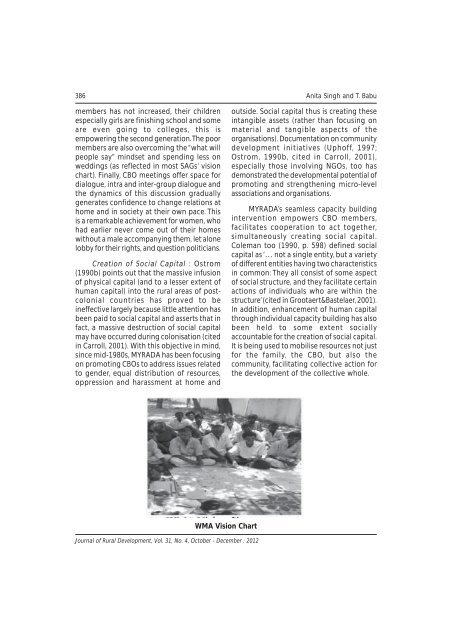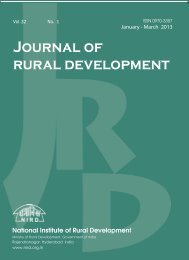MYRADA’S Capacity Building Intervention .... 385ensuring CBO sustainability, and its eventualweaning away from MYRADA.IMPACT OF CAPACITY BUILDING INTERVENTIONCapacity building intervention helpsmembers and other stakeholders understandand appreciate the concept <strong>of</strong> people’sinstitutions, and develop their skills,facilitating their participation in communitydevelopment by initiating, planning,analysing, and developing projects on theirown. In MYRADA, this intervention seems tobe effective for three reasons. First, it is asystemic approach involving all communitystakeholders and not just capacity builders,village leaders (who may be rich farmers, <strong>of</strong>higher caste, powerful, or well networked),and representatives <strong>of</strong> the base level CBOs(who are literate, or better <strong>of</strong>f than others).Second, and more importantly, it is thesimultaneous capacity building <strong>of</strong> scaled upCBOs as well as other stakeholders from thecommunity. Just as when stone is thrown inwater, capacity building intervention triggersripples <strong>of</strong> incremental impact at all levels.Third, this intervention does not end with thelast module in the training manual; it is anon-going process (CBO members inBasappanadoddi village said that as and whenthey need to learn a skill or awareness oncertain issues, they are themselvesapproaching CMRCs).CBO Empowerment : MYRADA’scapacity building intervention helps CBOsgrow into institutions which provide themwith the space to set their own agenda andto take steps towards poverty alleviationthrough a livelihood strategy in which thewhole family is involved. The dynamics <strong>of</strong>interaction among various stakeholders buildsskills to negotiate and resolve conflict.Women are taking the space traditionallyoccupied by men, such as initiating incomegenerating activities (tea shops, beautyparlour etc.) on their own; attending villagemeetings; questioning the political andvillage leaders; making decisions for theirfamilies, their CBOs, and for their village tosome extent. They have been earning respectfrom their husbands and other members <strong>of</strong>the community.In Chinchally village, after interviewingthe CBO members, we were invited to havelunch in the small “hotel” owned by one <strong>of</strong>the women members <strong>of</strong> Ganesha SAG.CBO members, more so, women havebecome savvy in financial transactions andare able to maintain their CBO common fundaccount, meet and talk to the bank <strong>of</strong>ficers,deposit their CBO savings, and ask forloans.The intervention has also created aculture <strong>of</strong> repayment (to group common fundand banks), which is not an easy taskespecially when working with poor,marginalised, and disadvantaged people. Inaddition, managing their SAGs has madewomen better managers compared to theirhusbands, especially in financial matters. Therigour <strong>of</strong> bookkeeping and recordmaintenance-considered important fortransparency, accountability, commitment,and finally the sustainability <strong>of</strong> the CBOs- isimpeccable in mature CBOs. They even keepmeticulous record <strong>of</strong> the meetings.In a WMA meeting in Gujjalanathavillage, the representative introducedme to the group, recorded mypresence in the meeting register, andat the end <strong>of</strong> the meeting requestedme to sign. A woman member <strong>of</strong>Beereshwara SAG from Basappandoddivillage said that they put socialpressure on other members not justto spend less on their children’smarriage but more importantly againstchild marriage <strong>of</strong> their daughters.Again, all CBO members have learnedto sign. Although adult literacy among CBOJournal <strong>of</strong> <strong>Rural</strong> <strong>Development</strong>, Vol. 31, No. 4, <strong>October</strong> - <strong>December</strong> : <strong>2012</strong>
386 Anita Singh and T. Babumembers has not increased, their childrenespecially girls are finishing school and someare even going to colleges, this isempowering the second generation. The poormembers are also overcoming the “what willpeople say” mindset and spending less onweddings (as reflected in most SAGs’ visionchart). Finally, CBO meetings <strong>of</strong>fer space fordialogue, intra and inter-group dialogue andthe dynamics <strong>of</strong> this discussion graduallygenerates confidence to change relations athome and in society at their own pace. Thisis a remarkable achievement for women, whohad earlier never come out <strong>of</strong> their homeswithout a male accompanying them, let alonelobby for their rights, and question politicians.Creation <strong>of</strong> Social Capital : Ostrom(1990b) points out that the massive infusion<strong>of</strong> physical capital (and to a lesser extent <strong>of</strong>human capital) into the rural areas <strong>of</strong> postcolonialcountries has proved to beineffective largely because little attention hasbeen paid to social capital and asserts that infact, a massive destruction <strong>of</strong> social capitalmay have occurred during colonisation (citedin Carroll, 2001). With this objective in mind,since mid-1980s, MYRADA has been focusingon promoting CBOs to address issues relatedto gender, equal distribution <strong>of</strong> resources,oppression and harassment at home andoutside. Social capital thus is creating theseintangible assets (rather than focusing onmaterial and tangible aspects <strong>of</strong> theorganisations). Documentation on communitydevelopment initiatives (Uph<strong>of</strong>f, 1997;Ostrom, 1990b, cited in Carroll, 2001),especially those involving NGOs, too hasdemonstrated the developmental potential <strong>of</strong>promoting and strengthening micro-levelassociations and organisations.MYRADA’s seamless capacity buildingintervention empowers CBO members,facilitates cooperation to act together,simultaneously creating social capital.Coleman too (1990, p. 598) defined socialcapital as ‘… not a single entity, but a variety<strong>of</strong> different entities having two characteristicsin common: They all consist <strong>of</strong> some aspect<strong>of</strong> social structure, and they facilitate certainactions <strong>of</strong> individuals who are within thestructure’ (cited in Grootaert&Bastelaer, 2001).In addition, enhancement <strong>of</strong> human capitalthrough individual capacity building has alsobeen held to some extent sociallyaccountable for the creation <strong>of</strong> social capital.It is being used to mobilise resources not justfor the family, the CBO, but also thecommunity, facilitating collective action forthe development <strong>of</strong> the collective whole.WMA Vision ChartJournal <strong>of</strong> <strong>Rural</strong> <strong>Development</strong>, Vol. 31, No. 4, <strong>October</strong> - <strong>December</strong> : <strong>2012</strong>

















